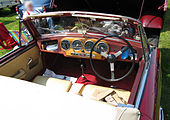Aston Martin DB2
| Aston Martin | |
|---|---|
|
Aston Martin DB2 Coupe (1950–1953)
|
|
| DB2 | |
| Production period: | 1950-1953 |
| Class : | Sports car |
| Body versions : | Coupé , convertible |
| Engines: |
Petrol engine : 2.6 liters (66–92 kW) |
| Length: | 4305 mm |
| Width: | 1651 mm |
| Height: | 1360 mm |
| Wheelbase : | 2511 mm |
| Empty weight : | 1118 kg |
| Previous model | Aston Martin 2-Liter Sports |
| successor | Aston Martin DB2 / 4 |
The Aston Martin DB2 is a sports car produced by the British car manufacturer Aston Martin . The DB2 was offered from 1950 to 1953 and was initially available as a coupé, later also as a convertible, which made up 25% of total production.
Vehicle characteristics
The DB2 was a big step forward over its predecessor, the 2-liter Sports , as it had a 2.6-liter 6-cylinder DOHC engine instead of the 4-cylinder OHV engine previously used. The DB2 was very successful on the racetrack and ensured future success for David Brown's company.
development
The DB2 prototype appeared as one of three Aston Martins at the 1949 Le Mans 24 Hours . They were labeled as VMF 63 , VMF 64 and VMF 65 . The car was built on Claude Hill's tubular frame chassis from the 2-liter Sport and had a coupé body designed by Frank Freeley.
The straight-six came from Lagonda , a company that David Brown bought for this purpose. The engine was originally designed by Walter Owen Bentley , namesake of the Bentley Automobile , and engineer Willie Wilson. The body of the DB2 was supplied by Mulliners of Birmingham .
The production model of the DB2 was first shown at the New York Auto Show in April 1950. Although the demand was high, copies 2 to 4 were reserved for use at the 24 Hours of Le Mans in 1950 . The cars took the first two places and were used again in 1951. The success brought fame to David Brown's rising company and convinced their management to build a range of vehicles specially designed for racing, starting with the DB3 .
production
411 DB2 were built from 1950 to 1953 from their conception. The first 49 copies had a three-part grille in the front and large rectangular air intakes on the sides. Among those first 49 copies were two Vantages. The first Vantage ever produced was the LML 50/21, which was delivered to the famous American racing driver Briggs Cunningham . Soon this design was replaced by the more familiar, rounded Aston Martin grill with horizontal bars. The three racing cars were modified accordingly to show the new company face.
The car was designed as a closed coupé with a small tailgate hinged on top to accommodate the spare wheel. There was space for luggage behind the front seats, accessible via the interior, as in the later Corvette C1 . The large bonnet was struck at the front.
In late 1950 a convertible version was introduced, of which at least 102 pieces were produced.
In January 1951, an optional engine with larger carburettors was offered as the first Aston Martin Vantage . In this version, the engine had more power with 125 bhp (92 kW). The word Vantage was found by an Aston Martin employee who searched a thesaurus for a suitable word for a more powerful version. In the same tradition, the words Volante were later found for the convertible versions and Virage for model series in the 90s and 2010s .
Web links
Individual evidence
- ↑ 1950 → 1951 Aston Martin DB2 'Team Car'. supercars.net, accessed August 12, 2012 .
- ^ Aston Martin DB2. barchetta.cc, accessed on August 12, 2012 .




